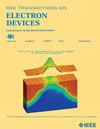Design and Fabrication of a Novel 1200 V 4H-SiC Trench MOSFET With Periodically Grounded Trench Bottom Shielding
IF 2.9
2区 工程技术
Q2 ENGINEERING, ELECTRICAL & ELECTRONIC
引用次数: 0
Abstract
In this article, a silicon carbide (SiC) trench MOSFET with periodically grounded p-type shielding region (P+SLD) at the trench bottom (PGP-TMOS) is designed and experimentally demonstrated. There exist deep-implanted P+ (DP) regions on both sides of the trench and the P+SLD is grounded by connecting to the DP region periodically. Therefore, the PGP-TMOS owns two different schematic cross section views. The P+SLD and DP region together improve the robustness of the gate oxide. A current spreading layer (CSL) by epitaxy is introduced to improve the device performance. Numerical 2D-simulation results show that compared with the trench MOSFET with floating P+SLD (FP-TMOS), the peak electric field in the gate oxide (一种具有周期性接地沟底屏蔽的新型1200v 4H-SiC沟道MOSFET的设计与制造
本文设计了一种在沟槽底部具有周期性接地P型屏蔽区(P+SLD)的碳化硅沟槽MOSFET (PGP-TMOS),并进行了实验验证。海沟两侧存在深部植入的P+ (DP)区,P+SLD通过周期性地与DP区连接而接地。因此,PGP-TMOS具有两种不同的原理图截面视图。P+SLD和DP区共同提高了栅极氧化物的稳健性。为了提高器件性能,引入了外延电流扩展层(CSL)。二维数值模拟结果表明,与带浮P+SLD的沟槽MOSFET (FP-TMOS)相比,栅极氧化物的峰值电场(${E}_{\text {ox,peak}}\text{)}$降低了50.77%,击穿电压(BV)和比导通电阻(${R}_{\text {on,sp}}\text{)}$基本保持不变。此外,PGP-TMOS具有优越的开关特性。PGP-TMOS已经在不同的晶圆上制造。当采用单外延片时,由于结场效应晶体管(JFET)效应和离子注入散射,样品的BV仅为1300 V,导通特性较差。当PGP-TMOS在外延引入CSL层的晶片上制造时,BV和${R}_{\text {on,sp}}$分别提高到1570 V和596 m $\Omega \cdot $ cm2。BV和${R}_{\text {on,sp}}$分别比前者提高了20.77%和91.85%。讨论了关键参数对PGP-TMOS的影响,为后续优化提供指导。
本文章由计算机程序翻译,如有差异,请以英文原文为准。
求助全文
约1分钟内获得全文
求助全文
来源期刊

IEEE Transactions on Electron Devices
工程技术-工程:电子与电气
CiteScore
5.80
自引率
16.10%
发文量
937
审稿时长
3.8 months
期刊介绍:
IEEE Transactions on Electron Devices publishes original and significant contributions relating to the theory, modeling, design, performance and reliability of electron and ion integrated circuit devices and interconnects, involving insulators, metals, organic materials, micro-plasmas, semiconductors, quantum-effect structures, vacuum devices, and emerging materials with applications in bioelectronics, biomedical electronics, computation, communications, displays, microelectromechanics, imaging, micro-actuators, nanoelectronics, optoelectronics, photovoltaics, power ICs and micro-sensors. Tutorial and review papers on these subjects are also published and occasional special issues appear to present a collection of papers which treat particular areas in more depth and breadth.
 求助内容:
求助内容: 应助结果提醒方式:
应助结果提醒方式:


